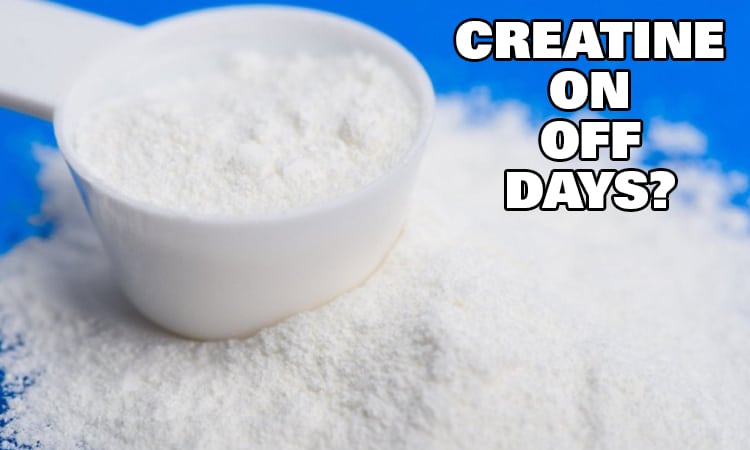
Creatine is one of the best supplements for strength, power, and muscle growth. It’s highly researched and proven to be effective and safe.
As a workout aid, questions often come up about when and how often to take creatine. It’s obvious why one would use it on a training day, but what about rest days?
Creatine should be taken every day, even on rest days from the gym, in order to keep muscles fully saturated.
Creatine provides benefit to the user in multiple ways. The reason you should take creatine every day is because it is stored in the muscle. Like a fuel tank, it should be topped off each day to make sure it works to its full potential.
Creatine is found naturally in meat and fish. However, the amount is low which typically makes supplementation necessary. For example, beef has about 1 gram of creatine per pound.
Creatine can be used by both men and women. Since it is a staple for some many men who use supplements, there is often apprehension among women about creatine. As explained here, there are numerous benefits for women who exercise when it comes to creatine supplementation.
How Creatine Works
Creatine is stored in muscle in the form of creatine phosphate. During high intensity exercise, the enzyme creatine kinase helps break down creatine phosphate so it can be used for energy.
Creatine is particularly useful for high intensity exercise because it creates energy very quickly. Unlike fats, or to a lesser extent carbohydrates, creatine can keep up with the demands of this intense exercise. When you’re sprinting as fast as you can or performing a very heavy lift, in all likelihood it is creatine that is providing energy for that activity.
The downside of creatine is that its capacity to provide energy is low. The tradeoff for rapid energy production is that it gets depleted very quickly.
Supplementing with creatine daily ensures that you’re getting the most out of this critical energy system.
Since the goal is daily creatine supplementation is to maximize its capacity in muscle, timing is not too important. Some people choose to take creatine pre or post workout, and there are arguments for both. But as long as the user is supplementing daily at some point in time, their creatine muscle levels will be full by the time they get to their next workout.
In addition to providing energy, creatine also increases the size of muscle cells. Creatine pulls water into the muscle, increasing the volume of the cells whilst also keeping them hydrated.
People will say that this is just water weight; well muscle is 70% water as it is. Contrary to popular belief, this also helps to prevent cramping as opposed to causing it.
The ability to increase strength and performance in the gym in addition to increasing the water content of muscle cells illustrates how creatine both directly and indirectly improves muscle growth.
More and more research is emerging on the beneficial effects of creatine on the brain. This includes things like short term memory improvement and intelligence. This improvement was particularly notable in vegetarians, since they would be unable to get creatine from their diet.
How Much Creatine to Take
During the initial dosing phase, it takes time for muscles to fully saturate with creatine.
A loading phase, which involves consuming 25 grams of creatine for a 5 day period followed by a maintenance dose from that point on, will saturate muscles more quickly. The downside is that the high dose sometimes causes stomach discomfort.
Other people choose to take a maintenance phase from the onset. This involves consuming 3-5 grams per day from the beginning. This protocol will take about a month to fully saturate muscles.
Whichever method you choose, eventually you will be consuming a 3-5 gram maintenance dose of creatine on both training and non-training days.
If you want to get really specific with your maintenance dose, you can multiply your bodyweight in kilograms by 0.3 to get the number of grams you should consume each day. But keep in mind that creatine is safe, and that a little more than whatever number you come up with is not a bad thing.
What is the Best Form of Creatine?
Creatine monohydrate has been proven to fill muscles with creatine and phosphocreatine to 100% capacity. Since you cannot beat 100%, there is no need to use any other form.
In fact, it could be deemed a risk to use other forms of creatine since they have not proven to be 100% effective. You could conceivably be in a position where you spend more money on a different form of creatine that produces suboptimal results.
Some people claim that creatine monohydrate makes them bloated so they opt for creatine hydrochloride. Creatine hydrochloride is a fine option, but again not superior to monohydrate.
The relationship between creatine and bloating is often misunderstood. This article goes into detail on the effects of creatine with bloating and water retention.
Supplementing with creatine monohydrate is a rare instance in which the cheapest form of a product is the best.
Recent Posts
Gym fanatics may find it hard to take rest days, but internally understand that it’s necessary for long-term muscle growth. Rest days allow the mind and body to recover and recharge for the next...
Creatine is by far the most proven and researched dietary supplement. It has been shown time and again to increase strength, power, and muscle mass. There are even some early indications that it may...
